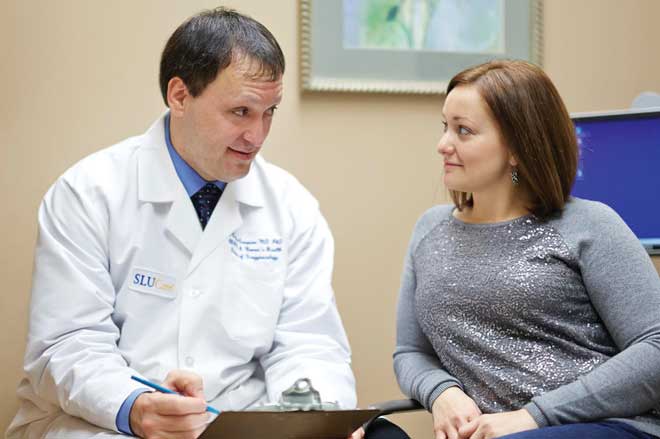It had been years of pain with no solution. Alicia Pharr had even tried surgery to cure her endometriosis, a painful condition sometimes leading to infertility in which endometrial tissue migrates into the pelvic region. When the surgery didn’t work, she turned to Dr. Patrick Yeung Jr., an endometriosis expert with SLUCare Physician Group and founder of the Saint Louis University Center for Endometriosis.
Yeung, along with the SLUCare pelvic pain team, which included Dr. E. Cristian Campian, finally unraveled the mystery behind Pharr’s constant discomfort. Endometriosis wasn’t the only culprit: She also had interstitial cystitis (IC), a chronic inflammation of the bladder wall. The multidisciplinary approach SLUCare offers was key to ridding Pharr of her pain.
“We have physicians and team members specializing in different things,” says Dr. Fah Che Leong, a SLUCare physician and professor of obstetrics, gynecology and women’s health at Saint Louis University. “Dr. Yeung is our endometriosis expert, Dr. Campian is our urogynecology expert with an interest in interstitial cystitis, and we also work with physical therapists. Not everyone suffers in the same way, and getting patients better requires more than one discipline.”
First, Pharr had surgery to treat her endometriosis. This time, the minimally invasive procedure was done with a carbon dioxide laser, which is more effective in ridding the patient of the rogue tissue than other techniques, Leong says. To treat her cystitis, Pharr followed a strict diet and underwent a series of bladder instillations, a mixture of medicines put directly into the bladder. “Dr. Campian figured out I had IC when I wasn’t feeling the results we had hoped for after surgery and I was having bladder pain,” Pharr says. “For multiple times every year, doctors would put me on medicine for UTIs—just antibiotic after antibiotic—but I never got better.”
Pharr also saw a physical therapist, which she says made a world of difference. “Everything in my pelvic floor was irritated, so the muscles in that area were always in a heightened state,” she explains. “The physical therapist helped the muscles relax.”
SLUCare patients like Pharr also have access to a pelvic pain support group. “I wanted to see what other people were saying about the diet and get recipes and ideas for things to eat,” she says. This fall, after her pain was mostly a memory, Pharr was asked to return to the group to provide inspiration for others. “Dr. Campian asked me to tell them my success story and how important it is to be patient and to do all the treatments simultaneously,” she says.
Like Pharr, many of SLUCare’s pelvic pain patients have gone through a series of doctors looking for a cure. “They’ve gone to the private physicians, the universities—we get patients from hours away,” Leong says. The most dangerous circumstance, he adds, is when these people have unnecessary surgery. “They might have gotten a hysterectomy and had their fallopian tubes and gallbladder removed, but still they experience pain. We make sure that when you get surgery, there’s a good reason behind it and a good chance it’s going to make you better.”
[SLUCare’s pelvic pain team practices at SSM St. Mary’s Health Center, 1031 Bellevue Ave., Ste. 400. For more information, call 314.977.7455 or visit slucare.edu/pelvicpain.]
Photo courtesy of SLUCare Physician Group
Pictured: Dr. E. Cristian Campian & Alicia Pharr
